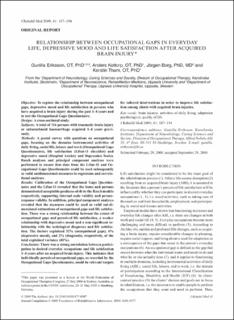Bitte benutzen Sie diese Kennung, um auf die Ressource zu verweisen:
https://doi.org/10.21256/zhaw-2055| Publikationstyp: | Konferenz: Paper |
| Art der Begutachtung: | Peer review (Publikation) |
| Titel: | Relationship between occupational gaps in everyday life, depressive mood and life satisfaction after acquired brain injury |
| Autor/-in: | Eriksson, Gunilla Kottorp, Anders Borg, Jörgen Tham, Kerstin |
| DOI: | 10.21256/zhaw-2055 10.2340/16501977-0307 |
| Erschienen in: | Journal of Rehabilitation Medicine |
| Band(Heft): | 41 |
| Heft: | 3 |
| Seite(n): | 187 |
| Seiten bis: | 194 |
| Angaben zur Konferenz: | World Federation of Occupational Therapists, Sydney, Australia, 27 July 2006 |
| Erscheinungsdatum: | 2009 |
| Verlag / Hrsg. Institution: | Stiftelsen Rehabiliteringsinformation, Foundation for Rehabilitation Information |
| ISSN: | 1651-2081 |
| Sprache: | Englisch |
| Schlagwörter: | Activities of daily living; Psychological adaptation; Brain injury; Cross-sectional study; Depressive disorder; Leisure activity; Personal satisfaction; Quality of life; Vocational rehabilitation; Subarachnoid hemorrhage |
| Fachgebiet (DDC): | 615.8515: Ergotherapie 616.8: Neurologie und Krankheiten des Nervensystems |
| Zusammenfassung: | Objective: To explore the relationship between occupational gaps, depressive mood and life satisfaction in persons who have acquired a brain injury during the past 1–4 years and to test the Occupational Gaps Questionnaire. Design: A cross-sectional study. Subject: A total of 116 persons with traumatic brain injury or subarachnoid haemorrhage acquired 1-4 years previously. Methods: A postal survey with questions on occupational gaps, focusing on the domains instrumental activities of daily living, social life, leisure and work (Occupational Gaps Questionnaire), life satisfaction (LiSat-11 checklist) and depressive mood (Hospital Anxiety and Depression Scale). Rasch analyses and principal component analyses were performed to ensure that data from the LiSat-11 and Occupational Gaps Questionnaire could be used subsequently as valid unidimensional measures in regression and correlational analyses. Results: Calibration of the Occupational Gaps Questionnaire and the LiSat-11 revealed that the items and persons demonstrated acceptable goodness-of-fit to the Rasch models respectively, supporting internal scale validity and person-response validity. In addition, principal component analyses revealed that the measures could be used as valid uni-dimensional estimations of occupational gaps and life satisfaction. There was a strong relationship between the extent of occupational gaps and perceived life satisfaction, a weaker relationship with depressive mood and a non-significant relationship with the aetiological diagnoses and life satisfaction. The factors explained 32% (occupational gaps), 6% (depressive mood), and 2% (diagnosis), respectively, of the total explained variance (40%). Conclusion: There was a strong correlation between participation in desired everyday occupations and life satisfaction 1–4 years after an acquired brain injury. This indicates that individually perceived occupational gaps, as recorded by the Occupational Gaps Questionnaire, could be relevant targets for tailored interventions in order to improve life satisfaction among clients with acquired brain injuries. |
| URI: | https://digitalcollection.zhaw.ch/handle/11475/8729 |
| Volltext Version: | Publizierte Version |
| Lizenz (gemäss Verlagsvertrag): | CC BY-NC 4.0: Namensnennung - Nicht kommerziell 4.0 International |
| Departement: | Gesundheit |
| Organisationseinheit: | Institut für Ergotherapie (IER) |
| Enthalten in den Sammlungen: | Publikationen Gesundheit |
Dateien zu dieser Ressource:
| Datei | Beschreibung | Größe | Format | |
|---|---|---|---|---|
| 2009_Kottorp_Relationship_between_occupational_gaps_JRM.pdf | 628.57 kB | Adobe PDF |  Öffnen/Anzeigen |
Zur Langanzeige
Eriksson, G., Kottorp, A., Borg, J., & Tham, K. (2009). Relationship between occupational gaps in everyday life, depressive mood and life satisfaction after acquired brain injury [Conference paper]. Journal of Rehabilitation Medicine, 41(3), 187–194. https://doi.org/10.21256/zhaw-2055
Eriksson, G. et al. (2009) ‘Relationship between occupational gaps in everyday life, depressive mood and life satisfaction after acquired brain injury’, in Journal of Rehabilitation Medicine. Stiftelsen Rehabiliteringsinformation, Foundation for Rehabilitation Information, pp. 187–194. Available at: https://doi.org/10.21256/zhaw-2055.
G. Eriksson, A. Kottorp, J. Borg, and K. Tham, “Relationship between occupational gaps in everyday life, depressive mood and life satisfaction after acquired brain injury,” in Journal of Rehabilitation Medicine, 2009, vol. 41, no. 3, pp. 187–194. doi: 10.21256/zhaw-2055.
ERIKSSON, Gunilla, Anders KOTTORP, Jörgen BORG und Kerstin THAM, 2009. Relationship between occupational gaps in everyday life, depressive mood and life satisfaction after acquired brain injury. In: Journal of Rehabilitation Medicine. Conference paper. Stiftelsen Rehabiliteringsinformation, Foundation for Rehabilitation Information. 2009. S. 187–194
Eriksson, Gunilla, Anders Kottorp, Jörgen Borg, and Kerstin Tham. 2009. “Relationship between Occupational Gaps in Everyday Life, Depressive Mood and Life Satisfaction after Acquired Brain Injury.” Conference paper. In Journal of Rehabilitation Medicine, 41:187–94. Stiftelsen Rehabiliteringsinformation, Foundation for Rehabilitation Information. https://doi.org/10.21256/zhaw-2055.
Eriksson, Gunilla, et al. “Relationship between Occupational Gaps in Everyday Life, Depressive Mood and Life Satisfaction after Acquired Brain Injury.” Journal of Rehabilitation Medicine, vol. 41, no. 3, Stiftelsen Rehabiliteringsinformation, Foundation for Rehabilitation Information, 2009, pp. 187–94, https://doi.org/10.21256/zhaw-2055.
Alle Ressourcen in diesem Repository sind urheberrechtlich geschützt, soweit nicht anderweitig angezeigt.